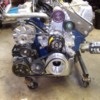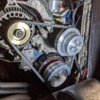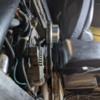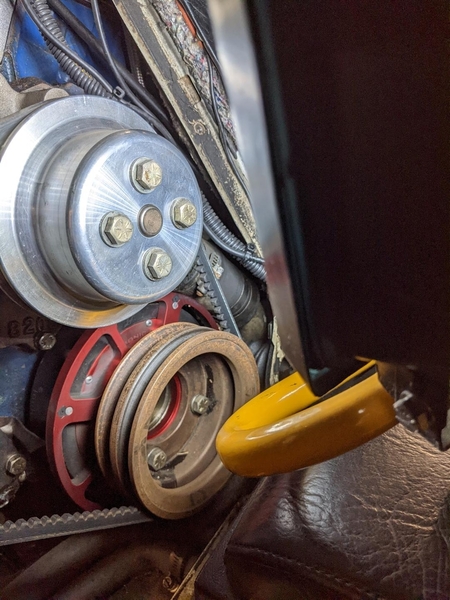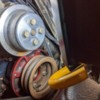I'm pretty sure it was the rebuilt pump's "loose" tolerance when the hub was pressed back onto it's shaft. The crank pulley and the alternator pulley were both aligned straightedge perfect, and with that spacer now the pump pulley is too......
I'm pretty sure it was the rebuilt pump's "loose" tolerance when the hub was pressed back onto it's shaft. The crank pulley and the alternator pulley were both aligned straightedge perfect, and with that spacer now the pump pulley is too......
Leaving the thermostat out completely WILL radically drop engine temperatures because the 'check valve' is gone and water flow is unrestricted. I remember a GT-5 that could NOT get its heater & defrosters to work 'cause the engine temp stabilized at 140F on hundred-mile highway runs. It only went to 170F during a hard driven open track event. Later, the owner found NO thermostat in there at all. Adding a 351-C thermostat allowed the heater & defrosters to work for the first time since he'd owned it.
Do you know which degree thermostat you have in your car? Is it a 180 degree?
Steve
I have no idea.....I probably changed it at the same time, but that was the 80's!
Bosswrench "The thermostat acts as a temp-controlled check valve, constantly opening, then closing a little, them reopening as engine loads change."
I was able to observe exactly those slight temp. fluctuations when lasering that pipe directly above the thermostat.
quote:Originally posted by Bosswrench:
These tests kind of reinforce my own results; regardless of what value thermostat you install, the engine temp winds up pretty much the same once the running engine is stabilized. All a lower value thermostat does is open sooner, not wider, so your stabilized engine temp is about the same. The thermostat acts as a temp-controlled check valve, constantly opening, then closing a little, them reopening as engine loads change. This changes water flow to the radiator. But even wide open, a thermostat is a large restriction to flow- as it was designed to be.
Leaving the thermostat out completely WILL radically drop engine temperatures because the 'check valve' is gone and water flow is unrestricted. I remember a GT-5 that could NOT get its heater & defrosters to work 'cause the engine temp stabilized at 140F on hundred-mile highway runs. It only went to 170F during a hard driven open track event. Later, the owner found NO thermostat in there at all. Adding a 351-C thermostat allowed the heater & defrosters to work for the first time since he'd owned it.
So if you were running a 351C in a race car, would you suggest leaving the thermostat out all together?

180°F (82°C) thermostat: The thermostat starts to open between the temperatures of 173°F and 180°F; the thermostat plugs the bypass orifice between the temperatures of 185°F and 192°F; and the thermostat is fully open between the temperatures of 198°F and 204°F.
192°F (89°C) thermostat: The thermostat starts to open between the temperatures of 185°F and 192°F; the thermostat plugs the bypass orifice between the temperatures of 197°F and 204°F; and the thermostat is fully open between the temperatures of 210°F and 216°F.
Thermostats are not ultra-precise devices, which is why it is necessary to write they open and close within a small range of temperatures, rather than at one precise temperature. Notice the Robertshaw 333 thermostat must open about 50% before it plugs the bypass orifice. If a cooling system is healthy proper thermostats (Robertshaw 333) of different ratings will regulate at different temperatures.
If a cooling system is stabilizing at the same temperature regardless of thermostat rating then one of two problems exist: (1) wrong thermostat or (2) the cooling systems heat removal capacity is marginal, the thermostat is operating wide open and not regulating anything.
I believe the Panteras cooling system has been marginal at low engine speed for 40 years. The SACC 4.9" pulley will help matters quite a bit. I think it will eventually be recognized as one of those "must have" type of parts.
-G
Attachments
quote:Originally posted by ItalFord:
I know I am really really late to this party but I finally got my SACC Fast Water Pump Pulley installed a couple of weeks ago. I did a full coolant flush to remove the 50/50 glycol mix that was in it. I replaced the coolant with plain water and two bottles of No-Rosion along with the fast pulley. I am noticing a 8-10 degree reduction in temperature when I drive in city traffic. Now it runs no hotter that 193 or so. Big improvement to the +200 temps that I used to get prior. The big test will be this summer I guess. Thanks Scott and George for your advice.
Better late than never right? lol
10 degree reduction is a pretty awesome result. We're glad it worked well for you!
Chris
For me well worth the ~$100 and 20 minutes to install.
Thanks Scott!
quote:I installed one of these last week with favorable results on my 71. I've done the cooling mods but it still ran a bit warm on the occasional drive home from work in silicon valley commuter traffic. By the temp gauge (moderately scientific) it lowered it by something like 10-15 deg at 0 to 10 MPH.
For me well worth the ~$100 and 20 minutes to install.
Thanks Scott!
That is AMAZING!!! Thanks for the post!!!
http://www.saccrestorations.ne...t-water-pump-pulley/
Folks,
We have be out of stock on this pully for some time now.
To date, I have done 3 production runs of this pully and I figured that was going to be about it since sales slowed down after the third run. (By the way, we sold many pullys to non-Pantera owners running the 351c in other vehicles.)
Anyway, Over the last 6 months I have had repeated requests for this pully so it is now back in stock and available for immediate shippment.
You too can enjoy the AMAZING results this pully has offered to many very happy customers.
Take care all, Scott
Hi, is this small waterpump pulley still availible? I can‘t find ist 🤷♂️
Thanks
Andreas
You can buy one at IPSCO IPS260-XX Billet Pantera Water Pump Pulleys - IPSCO I don't know if they are in stock, but call Mark on Monday. Larry
Hi Andreas,
If Scott at SACC doesn't have the pulley, Ipsco has it.
ips260-xx-billet-pantera-water-pump
John
Thank you for the fast reply!!
I strongly endorse purchasing from IPSCO. Mark Johnson was the first to offer this pulley, I think that deserves respect and taking your business to him.
Larry
Larry, SACC was first to introduce this pulley, this is the thread we introduced it in. Mark Johnson made the pulley for us until we started making it ourselves. Mark only started offering this pulley after we stopped selling it. He is the only source at this point but SACC pioneered this product!
Sorry, Scott.
I guess my memory of something from 10 years ago is a bit cloudy.
Larry
...What You call 'Perfect Alignment' is NOT!! 'Sighting-Down' does NOT Work! Even when we use our 'Good' Eye! Use a 'Straight-Edge' Bar, to Prove the Alignment of ALL the Pulleys!! The Adjustment Bracket is Bolted to the Rear of the Alternator on My own Engine, for a Perfect Alignment. Other Engines may be Different!! I am using the 100 Amp Alternator with the Internal Fan. This is a old photo before the 4.9" WP Pulley was Installed. I still say to use a 'Straight Edge' to Perfectly Align All Pulleys. Please see attached Photo.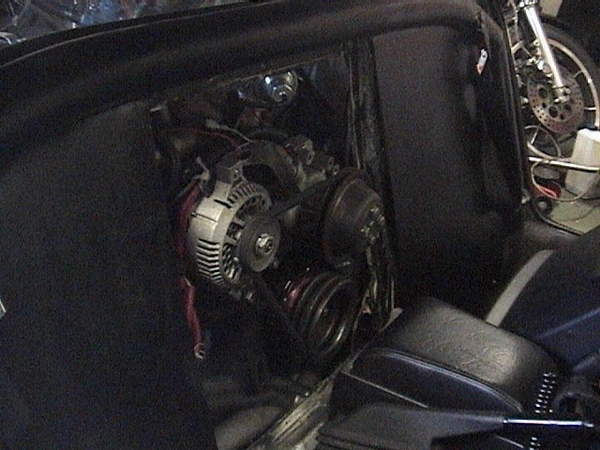
Also, use Two Washers under the Bolt HEAD, the first on, must be as Wide as the Adjusting Bar, as a Load Spreader, and for High Friction/Grip! The second washer allows the Bolt to 'Glide' for Tightening. And remember ALL Washers are 'Sharp' Side Down! Don't ask Me Why...Just Do It! I have since gone to a Bolt Long Enough to protrude beyond the Boss, so I could use a Nylok Nut, and washer, on the End to LOCK the Bolt from ever Vibrating Loose. This in turn, saves the Need to Over-Tighten the Bolt and Strip-Out the Aluminum Threads! ALL of this is to keep the belt tension adjustment from SLIPPING. I use a 'rod' of wood (broom-handle does Not Mar) to apply 'Leverage' tension on the Alternator and Belt while tightening the adjustment bolt...Last tighten the 'Pivot/hinge' Bolt! TOO much pressure on the Belt will wear the Alternator Forward Bearing Faster! TOO little tension will allow the belt to slip and squeal. The Alternator takes up to 15-17 Horsepower and More, to run when at full charging. Use Your Head and don't over-tighten! In My view the Proper Tension is Correct when the LONGEST Span of the Belt can be moved by moderate force, a total of One Inch, 1/2 inch to each side, along the Axis of Rotation. NO More...NO Less!
...And Yes! Since you can see here there is NO more adjustment using the Stock WP Pulley, that when I installed the 4.9" Pulley, I Did have to go to a SMALLER Belt! The Newer Pulley did Not Change the Alignment. As far as the 'Crank' Pulley, Notice the Belt is on the Forward Sheeve. Lay the straight edge across both sides of the crank pulley, now angle the end up, and it will just touch the face of the alternator pulley, they are aligned! After Running-In a Brand-new Belt, a Re-Adjustment is Necessary, as it will wear-in and stretch somewhat, and may start to slip and squeal.
Good Luck with it!
MJ
...Now, go Buy My 8 Inch Wheels.
Attachments
Turns out I did not install a Longer Adjuster BOLT for a Nylok Nut on the End!
Notice the Aftermarket Balance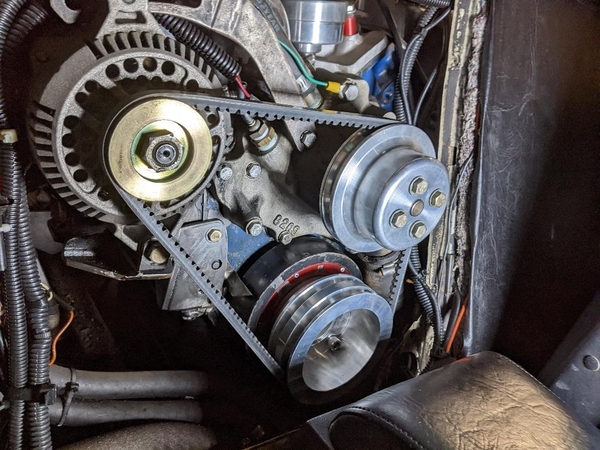
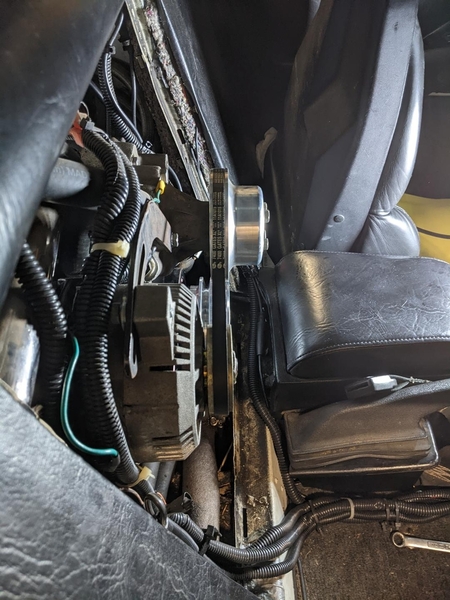 needed Spacer at a Thickness of 0.3480", I believe the Stock Balancer does Not need the Spacer...as the Stock Pulley and the Aluminum Pulley, side by side, are EXACTLY the Same Height!! The Aluminum Pulley being Just a Hair smaller in Diameter!
needed Spacer at a Thickness of 0.3480", I believe the Stock Balancer does Not need the Spacer...as the Stock Pulley and the Aluminum Pulley, side by side, are EXACTLY the Same Height!! The Aluminum Pulley being Just a Hair smaller in Diameter!
These Photos should answer a Lot of Your Questions!
MJ
P.S...when I Installed the New Crank Pulley I remove the MSD Crank Trigger WHEEL. The Spacer Makes up for the Thickness of the Wheel. The Entire Crank Trigger System for 351C will be posted for Sale. ALL pieces excepting for Your Choice of ECM...Electronic Ignition. See First Photo, Before Removal.
Thank You
Attachments
Attachments
15 to 17 hp and more for the alternator, wouldn't there be an error of zero?
16 hp = 12 kW = +/- 850A!!!!!!
No need to have studied electrical engineering, it is enough to have seen a 12 kW motor or alternator once to know that weight and volume are absolutely not comparable to those of a car alternator.
And with a little bit of mechanical engineering it is easy to calculate the force exerted on the belt by a 1100W alternator (+/-80A) at full load at 2000 rpm for example, it is +/- 17 lbs .
If you're interested I can tell you the details of the calculation, it's easy to understand by everyone, there are no complicated mathematical functions, only multiplications and divisions.


